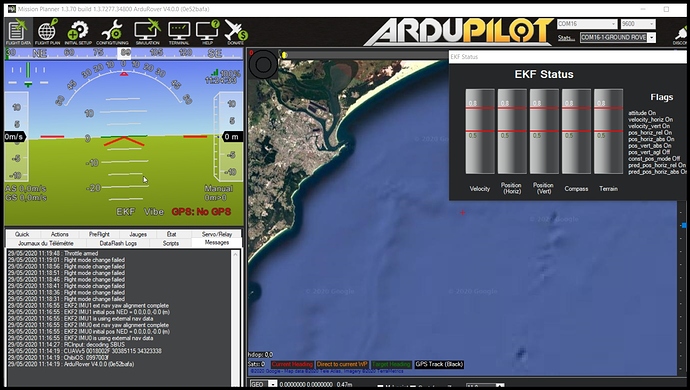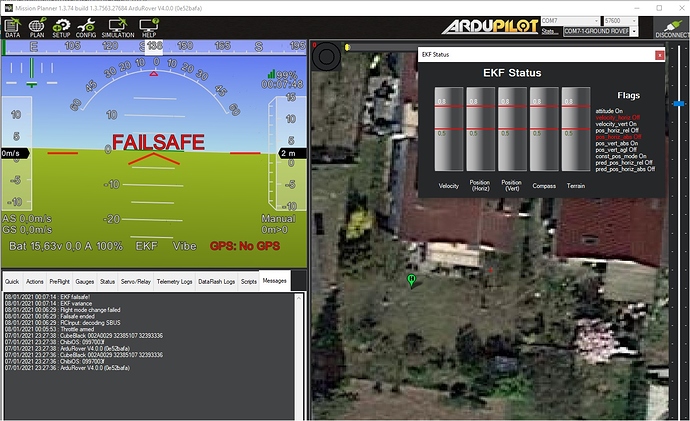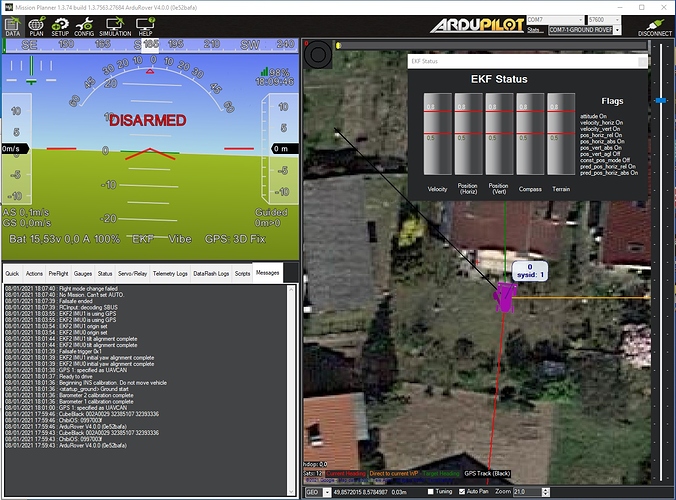Dear All,
Here is the set up: there is a companion computer (NUC) which is connected via TELEM2 to the ArduRover
On the NUC, we have a 2D SLAM which is computing x,y and yaw. These values are sent to the ArduRover via Mavros.
When I launch all the nodes, I can see that after few seconds, the EKF is correctly initialized as it is shown on the MissionPlanner’ screenshot below:
My problem is the following: I cannot arm neither change the mode from MANUAL to GUIDED using a “wellknown” piece of code which is detailed at the end f the message.
but if I do: rosrun mavros mavsafety arm, I am able to arm the rover.
However if I do : rosrun mavros mavsys -c GUIDED, I got an error from ArduRover “Flight Mode change failed” but I do not know the reason…
So can we use the code below to run MAVROS with ArduRover? If so please can you tell me where am I wrong? Besides I noticed some Clock/Time Syncronisation between ArduRover and MAVROS (even though I set BRD_RTC_TYPES = 2). Mavros topics are updated anyway.
Actually I have an additional question because we are using PX4 for quadrotors and in order to set the OFFBOARD mode (GUIDED for ardurover), you need to send at a given frequency setpoints for instance. Is it the same with GUIDED and ardurover?
I attached the list of parameters as well because there are a lot of parameters I have changed and may be there is one I missed…1 29-05-2020 11-26-05.bin.log.param (15.7 KB)
I have also logs but I do not know which one to provide (.bin, bin.kmz, log or log.gpx), please tell me which is the one that you may want to have a look to.
Any help warmly appreciated.
@rmackay9 sorry to bother you but I saw that you are very active in ROS + Ardurover so may I ask you if you have any hint about these issues ?
#include <ros/ros.h>
#include <geometry_msgs/PoseStamped.h>
#include <mavros_msgs/CommandBool.h>
#include <mavros_msgs/SetMode.h>
#include <mavros_msgs/State.h>
mavros_msgs::State current_state;
void state_cb(const mavros_msgs::State::ConstPtr& msg){
current_state = *msg;
}
int main(int argc, char **argv)
{
ros::init(argc, argv, "offb_node");
ros::NodeHandle nh;
ros::Subscriber state_sub = nh.subscribe<mavros_msgs::State>("mavros/state", 10, state_cb);
ros::Publisher local_pos_pub = nh.advertise<geometry_msgs::PoseStamped>("mavros/setpoint_position/local", 10);
ros::ServiceClient arming_client = nh.serviceClient<mavros_msgs::CommandBool>("mavros/cmd/arming");
ros::ServiceClient set_mode_client = nh.serviceClient<mavros_msgs::SetMode>("mavros/set_mode");
//the setpoint publishing rate MUST be faster than 2Hz
ros::Rate rate(20.0);
// wait for FCU connection
while(ros::ok() && !current_state.connected){
ros::spinOnce();
rate.sleep();
}
geometry_msgs::PoseStamped pose;
pose.pose.position.x = 0;
pose.pose.position.y = 0;
pose.pose.position.z = 2;
//send a few setpoints before starting
for(int i = 100; ros::ok() && i > 0; --i){
local_pos_pub.publish(pose);
ros::spinOnce();
rate.sleep();
}
mavros_msgs::SetMode offb_set_mode;
offb_set_mode.request.custom_mode = "GUIDED";
mavros_msgs::CommandBool arm_cmd;
arm_cmd.request.value = true;
ros::Time last_request = ros::Time::now();
while(ros::ok()){
if( current_state.mode != "GUIDED" &&
(ros::Time::now() - last_request > ros::Duration(5.0))){
if( set_mode_client.call(offb_set_mode) &&
offb_set_mode.response.mode_sent){
ROS_INFO("Guided enabled");
}
last_request = ros::Time::now();
} else {
if( !current_state.armed &&
(ros::Time::now() - last_request > ros::Duration(5.0))){
if( arming_client.call(arm_cmd) &&
arm_cmd.response.success){
ROS_INFO("Vehicle armed");
}
last_request = ros::Time::now();
}
}
local_pos_pub.publish(pose);
ros::spinOnce();
rate.sleep();
}
return 0;
}



